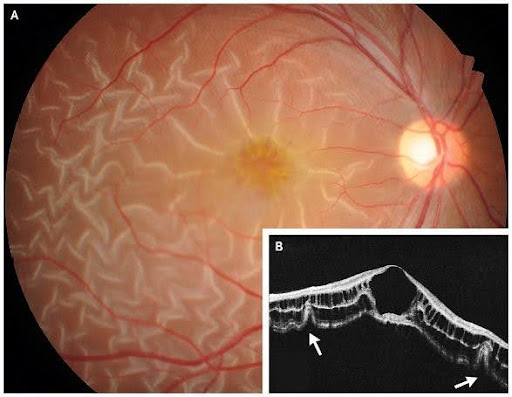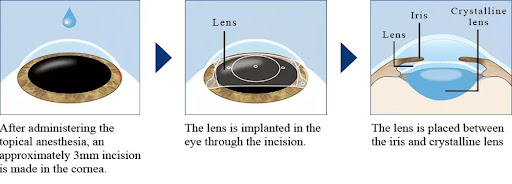Retinoschisis is a condition that occurs when the retina—the delicate layer at the back of the eye—splits into two layers. This condition can have a profound impact on vision, making it essential to understand its causes and implications.
In this informative article, we delve into the nuances of retinoschisis, its impact on vision, and the expert perspectives from Eyeonce Eye Clinic, with notable professionals like Dr. Paik Dong Won and Jung Sae Rom.
What causes retinoschisis?
The real cause of retinoschisis involves a complex interplay of factors affecting the delicate structure of the retina. Here are the key points:
- Genetic Predisposition – There is evidence suggesting a genetic link to retinoschisis, with a higher likelihood of developing the condition if it runs in the family.
- X-Linked Juvenile Retinoschisis (XLRS) – In cases of X-linked juvenile retinoschisis, a specific gene mutation on the X chromosome is often identified as a primary cause. This mutation can lead to the splitting of retinal layers.
- Structural Abnormalities – Anatomical irregularities in the structure of the retina can contribute to retinoschisis. These abnormalities may affect the way the layers of the retina adhere to each other.
- Age-related Changes – While less common, age-related changes in the retina, such as degeneration or weakening of tissues, can also play a role in the development of retinoschisis, particularly in older individuals.
- Vitreous Traction – The vitreous, the gel-like substance within the eye, can exert traction on the retina. Excessive traction, especially in certain areas, may lead to the separation of retinal layers.
- Inflammatory conditions – Inflammation within the eye, caused by infections or autoimmune disorders, can contribute to retinoschisis by affecting the stability of the retinal layers.
- Eye Trauma – Physical trauma to the eye, such as injury or surgery, can disrupt the normal structure of the retina and contribute to the development of retinoschisis.
Eyeonce Eye Clinic strongly agrees that understanding the multifaceted nature of these factors is crucial for comprehending the diverse causes of retinoschisis and tailoring effective treatment approaches based on the underlying factors in each case. At Eyeonce, offer comprehensive, personalized consultation for accurate diagnosis.
What are the symptoms of retinoschisis?
Retinoschisis can manifest with various symptoms, affecting visual perception and potentially impacting daily activities. Here are the key symptoms associated with retinoschisis:
- Blurred or Distorted Vision – One of the primary symptoms is a noticeable blurring or distortion of vision. Straight lines may appear wavy and overall visual clarity may be compromised.
- Difficulty in Reading or Recognizing Faces – Individuals with retinoschisis may experience challenges in reading, recognizing faces, or discerning details, particularly in fine print or intricate patterns.
- Central Vision Impairment – Retinoschisis often affects central vision, which is crucial for activities that require focused and detailed sight, such as reading or driving.
- Peripheral Vision Affected – In some cases, retinoschisis can extend beyond central vision, impacting peripheral vision. This can contribute to difficulties in navigating surroundings.
- Floaters or Spots – Patients may notice the presence of floaters or spots in their visual field. These floaters can be perceived as dark specks or lines that seem to drift across the visual field.
- Color Vision Changes – Some individuals with retinoschisis may experience alterations in color vision, perceiving colors differently or less vividly than before.
- Decreased Visual Acuity – The overall sharpness of vision may decrease, leading to a reduction in visual acuity. This can affect the ability to see objects clearly at various distances.
Eyeonce Eye Clinic’s Paik Dong Won and Jung Sae Rom recommend early timely consultation since these symptoms can also be indicative of other eye conditions. With their expertise, you will receive not only a comprehensive eye examination but also an accurate diagnosis.
Diagnosis of Retinoschisis
Diagnosis of Retinoschisis
- Comprehensive Eye Exam – Eye care professionals, including those at Eyeonce Eye Clinic, conduct a thorough eye examination to assess the overall health of the eyes and identify any abnormalities.
- Visual Acuity Test – Measurement of visual acuity helps determine the clarity and sharpness of vision, a crucial step in diagnosing retinoschisis.
- Retinal Examination – Direct visualization of the retina is essential. This may involve the use of specialized instruments to examine the layers of the retina for any signs of schisis (splitting).
- Optical Coherence Tomography (OCT) – This non-invasive imaging technique provides high-resolution cross-sectional images of the retina, aiding in the detection and characterization of retinoschisis.
Advanced Imaging Techniques
- Fluorescein Angiography – In some cases, a fluorescein dye may be injected into the bloodstream, and imaging is performed to highlight blood vessels and identify abnormalities in retinal circulation.
- Ultrasound – In situations where traditional imaging methods may be challenging, ultrasound imaging can be utilized to visualize the eye’s internal structures.
Treatment Options for Retinoschisis
Surgical Interventions
- Vitrectomy – In severe cases, surgical intervention may be recommended. Eyeonce Eye Clinic, with its advanced facilities, may perform vitrectomy—a procedure to remove the vitreous gel and address traction on the retina.
- Retinal Detachment Repair – If retinoschisis is associated with or leads to retinal detachment, surgical repair becomes necessary. This may involve reattaching the retina using laser surgery or scleral buckling.
Non-Surgical Approaches
- Observation – In cases of mild retinoschisis without significant impact on vision, a conservative approach of monitoring may be adopted, especially if there is no progression.
- Corrective Lenses – Prescription lenses, such as glasses or contact lenses, may help improve vision by compensating for refractive errors caused by retinoschisis.
- Regular Monitoring – Continuous monitoring of retinoschisis through periodic eye exams is crucial to assess progression and determine the need for further intervention.
At Eyeonce Eye Clinic, renowned experts like Dr. Paik Dong Won and Jung Rae Som bring their expertise to the diagnosis and treatment of retinoschisis.
Why choose Eyeonce Eye Clinic Gangnam for Retinoschisis treatment?
Utmost Patient Care
Our eye care professionals and staff ensure to give you your money’s worth. We guarantee you receive the best medication possible and assure you that you are guided and understood, making you feel comfortable and confident at every step.
Comprehensive Consultation
Eyeonce Eye Clinic offers comprehensive eye examinations to evaluate your condition and determine the best eye strain treatment. Our ophthalmologists take their time to cater to your questions and address your concerns, ensuring you make an informed decision about our vision correction options.
Expert Eye Doctors
Our ophthalmologists, Head Director Dr. Paik Dong Won and Medical Director Dr. Jung Sae Rom, are highly knowledgeable and adept in treating eye strain. They always use the latest techniques and technologies to ensure optimal results.
Frequently Asked Questions (FAQs)
Common symptoms include blurred or distorted vision, difficulty reading or recognizing faces, peripheral vision impairment, floaters or spots in the visual field, and changes in color vision.
Retinoschisis can have various causes, including genetic predisposition, structural abnormalities in the retina, age-related changes, vitreous traction, inflammatory conditions, and eye trauma.
Retinoschisis is a relatively rare eye condition. It may be more prevalent in individuals with a family history of the condition due to genetic factors.
Conclusion
Retinoschisis—though rare—can significantly impact vision, underscoring the importance of awareness and early intervention. That is why understanding the complexities of retinoschisis is the first step toward effective management. Eyeonce Eye Clinic, led by esteemed experts Dr. Paik Dong Won and Jung Sae Rom, stand at the forefront of comprehensive eye care, offering personalized treatment plans using cutting-edge diagnostic equipment. Book an appointment with them today!



